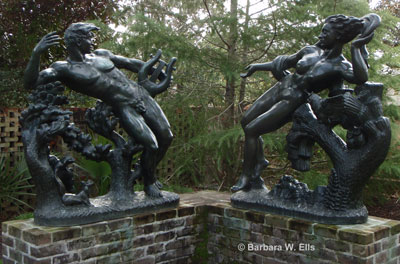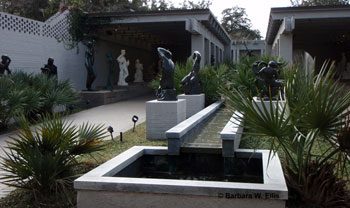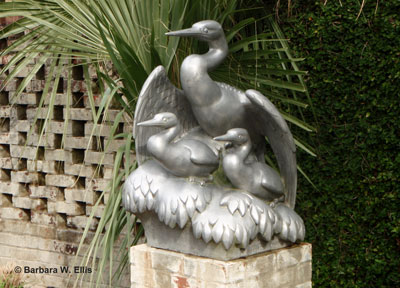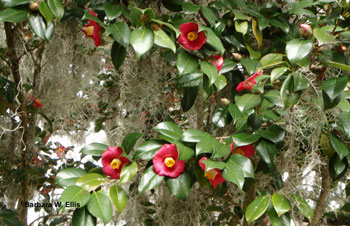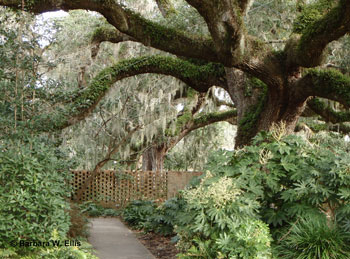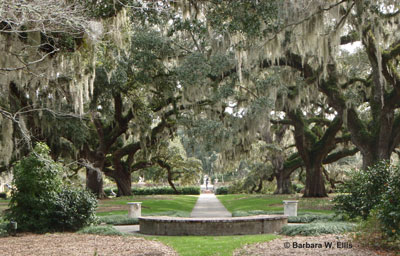
An allee of live oaks (Quercus virginiana) fills one of the central rooms of the garden at Brookgreen. It dates from the early 18th century and originally marked the entrance to the plantation.
While it may not be the best idea to admit that I’ve been spending time in the balmy south while gardens and gardeners up north are freezing, I had a chance to visit a public garden I’ve long wanted to see: Brookgreen, a renown sculpture garden and National Historic Landmark located in Murrels Inlet, South Carolina. I’ve always loved art and ornaments in gardens, and Brookgreen didn’t disappoint. Hollies, live oaks decked with Spanish moss, and camellias line the gorgeous mile-long entrance drive. (We even saw Southern Fox Squirrels, with their black heads and white ears on the way in!) Once we arrived at the Welcome Center, I picked up a map at the Welcome Center and wandered into the sculpture gardens beyond.
Brookgreen’s sculpture collection is more than a few steps above ordinary garden art. After all, how many of us can accommodate full-size sculptures of horses or lions in our gardens – or a life-size bronze of Orpheus and Eurydice saying their last good-bye?
The size of the collection is staggering. Opened in 1932 by founders and designers Archer and Anna Hyatt Huntington, Brookgreen features 1,200 pieces displayed in the garden as well as in a sculpture court and two indoor galleries. Overall, Brookgreen features a formal design, with classic garden rooms, ornamental ponds, and sculpture at every turn.
While the massive bronze and marble pieces were awe-inspiring, my favorite pieces were the smaller ones, including one of a female anhinga sheltering nestlings set on a simple brick base surrounded by ground covers. It would fit in even a small garden.
Since I am, by nature, an informal-garden type girl, I especially enjoyed the Children’s Garden, which featured winding paths and exuberant use of ornamental cabbages as ground cover. A driftwood archway marked the entrance to one pathway leading to sculptures of bears and butterflies.
Another piece in the Children’s Garden that I absolutely loved is a chimp cast in bronze sitting on a plinth set in a clump of now-dormant hydrangeas.
While undoubtedly the garden is more colorful in spring or summer, even in winter, Brookgreen features plants that will turn heads. The massive branches of the live oaks are thick with resurrection ferns, which dry up then come back to life when it rains. Branch tips are always thickly draped in that ever-present bromelliad, Spanish moss. Even the camellias come decorated with Spanish moss (Tillandsia usneoides).
The garden promises to be even more beautiful as the weather warms. Massive plantings of daffodils were beginning to show color when we visited the garden, and will be soon followed by azaleas, dogwoods, and more. Whether you love sculpture or plants or both, Brookgreen is worth a visit.
If you go: If you’re visiting South Carolina’s “Grand Strand” and Myrtle Beach, make time early in your visit to stop by Brookgreen. Tickets cost $12 ($10 for seniors; $5 for children 6 to 12; children 5 and under are free) and are good for entrance to the garden for seven consecutive days. That’s a good thing since there’s lots more to see than the sculpture gardens: There are creek cruises, history and nature trails, exhibits of native animals and heritage farm animals, plus an aviary built over an existing swamp. See Brookgreen’s website for more information: www.brookgreen.org.

